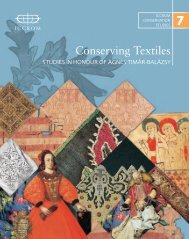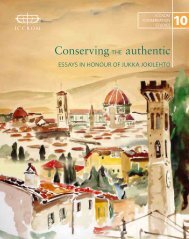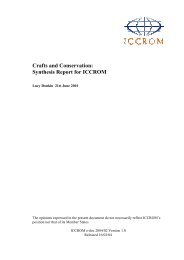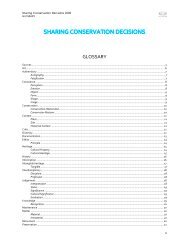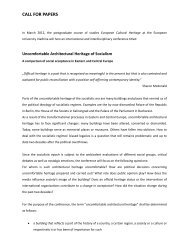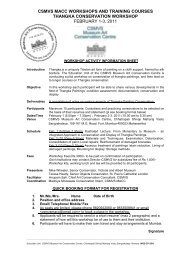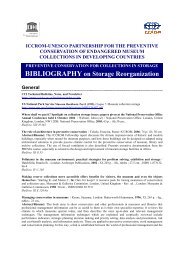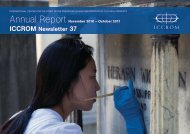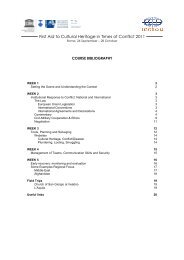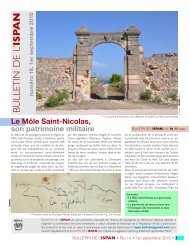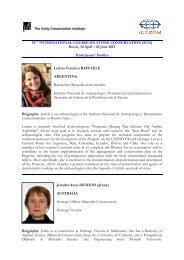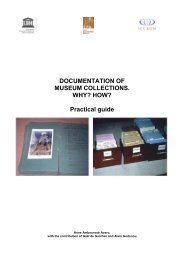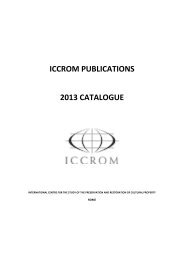part 1 - Iccrom
part 1 - Iccrom
part 1 - Iccrom
Create successful ePaper yourself
Turn your PDF publications into a flip-book with our unique Google optimized e-Paper software.
MEASURING HERITAGE CONSERVATION PERFORMANCE<br />
6th International Seminar on Urban Conservation<br />
that can be measured by following up the filing of<br />
demolition and new work forms. Regarding the<br />
statements of Environmental Protection Areas and<br />
Historical Protection Areas, a plan is being devised<br />
to permit monitoring (identification, recording, and<br />
assessment tasks) in those areas, as an evaluation<br />
tool to measure effectiveness of the proposed conservation<br />
measures.<br />
Last but equally important are the supervision<br />
actions that must be proposed in relation to the<br />
interventions in the buildings included in the<br />
inventory.18 Establishing protection degrees to<br />
limit and define the permitted actions on the property<br />
becomes worthless if compliance is not supervised.<br />
It is also necessary to have a comprehensive<br />
preventive conservation program of that unique<br />
property in order to ensure its conservation conditions<br />
once intervention has been made.19 It is worth<br />
remembering that one of the primary dimensions of<br />
heritage is its documentary nature, and each intervention<br />
damages the property to a higher or lower<br />
degree. Therefore, the actions must be anticipated in<br />
order for harm to be minimized.<br />
Conclusion<br />
From the mid-20 th century until the enactment of<br />
the Rosario Urban Plan, the instruments responsible<br />
for preserving and conserving urban cultural<br />
heritage proved to be inadequate and insufficient.<br />
Isolated efforts, an elaboration of the inventory or<br />
an approximation to the definition of Historical Protection<br />
Areas, cannot be managed in a sustainable<br />
way. Heritage management policies must cease to<br />
be restrictive and must permit city transformations<br />
through the effective inclusion of the heritage property<br />
in urban planning.<br />
In the recent years the Conservation Program has<br />
developed a sustained action in relation to urban<br />
heritage, eliminating the dissociated interpretation<br />
of heritage and urban development, and including<br />
it as an inseparable factor in the constitution of the<br />
city landscape. While cultural heritage refers to the<br />
inhabitants’ identity and the city memory — the<br />
identity dimension — its potential cannot be wasted<br />
in relation to its capacity to promote urban transformations<br />
and local development. So far, actions have<br />
focused on the identity dimension rather than on<br />
the transformation potential, economic appraisal,<br />
sustainability and <strong>part</strong>icipation of citizens.<br />
As I see it, however, guidelines or instruments<br />
have to be devised to evaluate the effectiveness of<br />
the proposed actions and to monitor their effect in<br />
the long term. Imbalances must be noticed, and the<br />
instruments that directly or indirectly act on complex<br />
heritage property must be self-regulated or<br />
adjusted. Preventive conservation has contributed<br />
a new commitment to follow up and control<br />
actions on cultural property, struggling for minimal<br />
interventions, potential to reverse actions and supported<br />
by scientific knowledge. Urban heritage conservation<br />
policies should be ruled in the same way,<br />
introducing conservation and intervention evaluation<br />
and monitoring tools.<br />
From the aforesaid, several questions arise:<br />
• Which indicators account for the effectiveness<br />
of the conservation policies<br />
implemented?<br />
• Is monitoring a key tool?<br />
• Who must execute it?<br />
• Does citizens’ <strong>part</strong>icipation have the highest<br />
potential to follow up the actions that<br />
compromise urban heritage?<br />
If the citizens are uninterested in conservation,<br />
nothing can be sustained. Heritage protection is not<br />
feasible just with the elaboration of property inventories<br />
or protective regulations. These represent the<br />
reference framework and the starting point of a continuous<br />
and permanent follow-up and monitoring<br />
of actions, which public conservation policies elaborate<br />
in relation to urban landscape transformations.<br />
References<br />
Martinez de San Vicente, I. 1985. La formación<br />
de la estructura colectiva de la ciudad de Rosario.<br />
Cuadernos del CURDIUR. Facultad de Arquitectura,<br />
Planeamiento y Diseño. Universidad Nacional de<br />
Rosario.<br />
Plan Director de Rosario. Bases para el acuerdo.<br />
Documento integrado. 2001.Tomo I y II. Secretaria<br />
de Planeamiento Urbano. Plan Director. Edición<br />
Digital.<br />
Programa de Preservación y Rehabilitación del<br />
Patrimonio. Informe estadístico. 2004. Expedientes<br />
de vización previa.<br />
Recopilación de Ordenanzas, decretos, decretoordenanzas,<br />
decreto Concejo Deliberante referidas<br />
a patrimonio. (Available at: http://www.rosario.<br />
gov.ar/normativa, leyes provinciales y nacionales).<br />
Rainero, C. 2012. How to register memory? Documentation, recording, archiving and preservation of intangible cultural heritage in<br />
Venezuela. In Zancheti, S. M. & K. Similä, eds. Measuring heritage conservation performance, pp. 59-66. Rome, ICCROM.<br />
65



